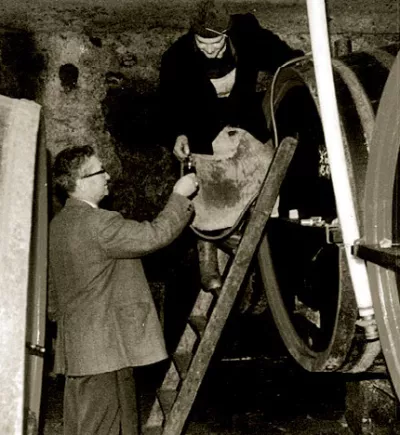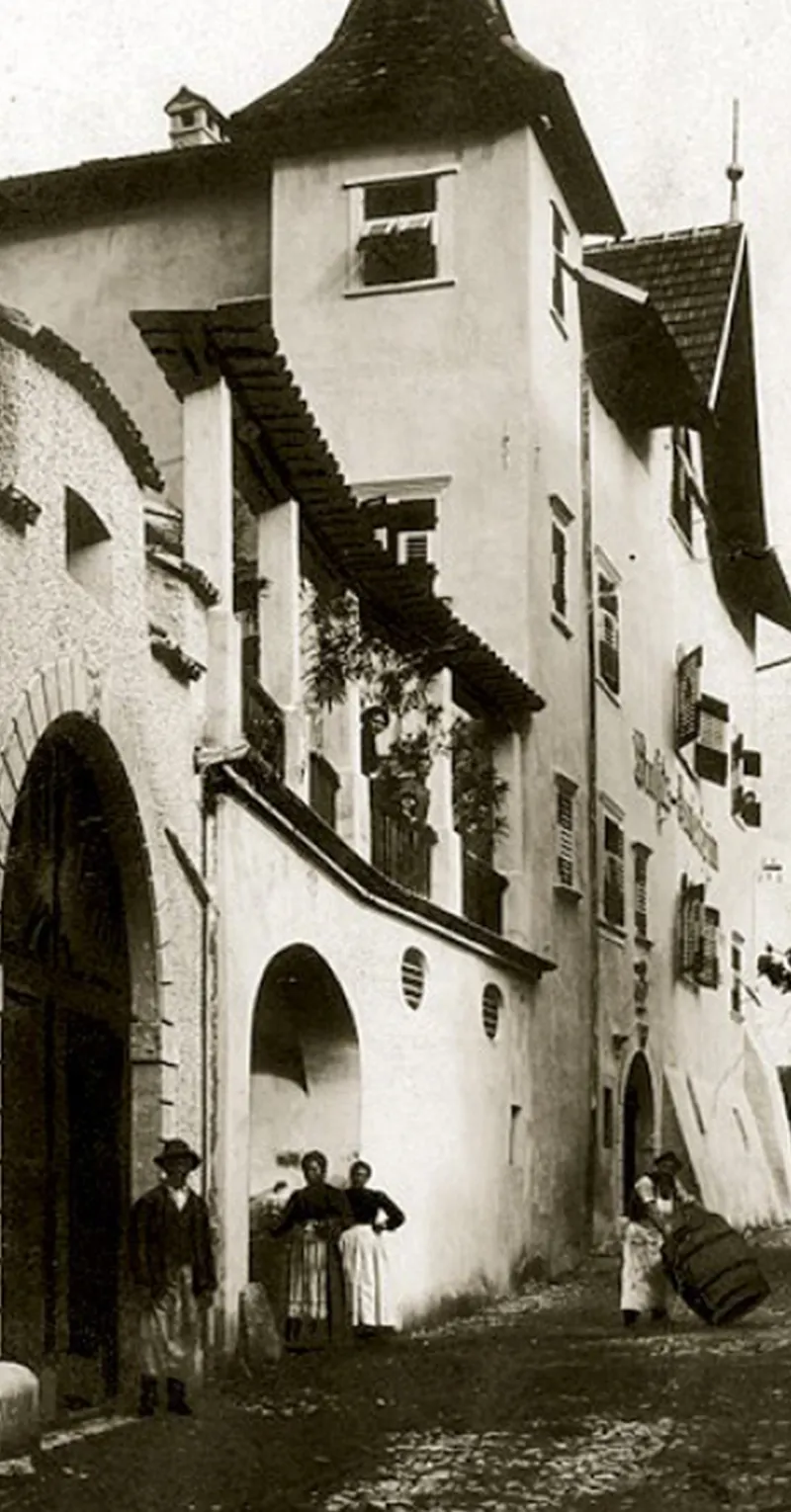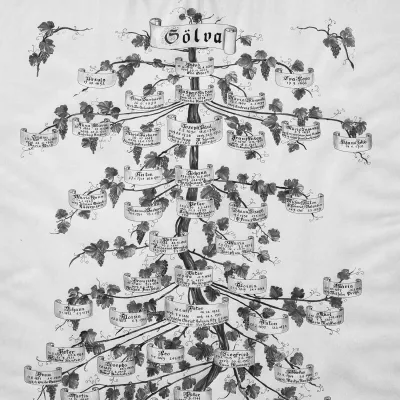
1964 tasting from the barrel - Siegfried Sölva & Peter Sölva
Development history of our winery until today
Viticulture since 1731
The winery Peter Sölva is one of the oldest wine-growing businesses in Caldaro. We are a family business which has been passed on to the next generation for hundreds of years. Documents go back to 1731 showing that our family has grown grapes, made and sold wine without a break for 11 generations.
Family history was and still is at the centre of our work and describes our 2 wine selections with the historical names of our family DeSILVA
(signature of the soil, old vines) and AMISTAR (signature of the family, reminder of our Spanish roots).
These two family names not only designate our wines, but also identify us personally as a historic winegrowing family. With this family tradition, it was of course also important to us to continue to cultivate the local varieties, but also to look to the future in an innovative way.
Our family's quality-conscious work has earned us numerous awards throughout the farm's history, confirming our philosophy time and again. Among our important customers was also the world-famous monastery of St. Peter in Salzburg, and the prize awarded by the Association of Agricultural Enterprises of German South Tyrol in 1908 in Bolzano at the German-Tyrolean wine market also stimulated the upheaval and reorganisation of the winegrowing business at the beginning of the 20th century.
Until 1960 we produced small quantities of 0,75lt bottled wines and above all draught wines, which were sold in litre bottles or 50lt wooden barrels to the gastronomy of South Tyrol, Austria, Switzerland and to Munich.
Family history was and still is at the centre of our work and describes our 2 wine selections with the historical names of our family DeSILVA
(signature of the soil, old vines) and AMISTAR (signature of the family, reminder of our Spanish roots).
These two family names not only designate our wines, but also identify us personally as a historic winegrowing family. With this family tradition, it was of course also important to us to continue to cultivate the local varieties, but also to look to the future in an innovative way.
Our family's quality-conscious work has earned us numerous awards throughout the farm's history, confirming our philosophy time and again. Among our important customers was also the world-famous monastery of St. Peter in Salzburg, and the prize awarded by the Association of Agricultural Enterprises of German South Tyrol in 1908 in Bolzano at the German-Tyrolean wine market also stimulated the upheaval and reorganisation of the winegrowing business at the beginning of the 20th century.
Until 1960 we produced small quantities of 0,75lt bottled wines and above all draught wines, which were sold in litre bottles or 50lt wooden barrels to the gastronomy of South Tyrol, Austria, Switzerland and to Munich.
read more
It was only a few years after the Second World War that more and more wine was bottled in litre bottles and then more and more in 0.75lt bottles. Over the years, there have been many positive developments in viticulture (vineyard variety projects) and cellar management. In 1963, the so-called designations of origin were established in order to better control the cultivation and its quality. For example, the cultivation with a different cultivation system became interesting - the wire frame. In 1985, we also made the first trials with this cultivation system.
Due to the location, the winery produces 60% red wines in our valley locations around Lake Kaltern between 224 - 400 metres above sea level and 40% white wines in our hillside locations between 400 - 600 metres above sea level.
The red varieties focus on Cabernet Sauvignon - Franc, Merlot and Lagrein. Historically, we also work with autochthonous grape varieties such as Vernatsch and Lagrein, and in some new vineyards with Pinot Noir. The white varieties focus on Pinot Blanc, Sauvignon Blanc and Chardonnay. We also work with the autochthonous grape variety Gewürztraminer and in some new vineyards with Pinot Grigio/Grauburgunder and Muskateller.
In the last few years of our company's history, we have primarily worked on our wine range and its sustainable and respectful quality management in the vineyard, in order to preserve our nature with respect for the next generations, step by step, according to the common South Tyrolean plan of Agenda 2030.
In cellar technology, too, it was always necessary to rethink, to adapt to natural cycles and to modernise our machinery in such a way that our grape qualities can be processed much more selectively and, above all, gently. In 1986, in addition to the large wooden barrels and stainless steel tanks, we also began to work increasingly with smaller wooden barrels such as barriques and tonneaux.
With these two family names we not only identify ourselves personally with our wines, but also as a historical wine-growing family. This family tradition was, of course, important enough for us to continue maintaining the local varieties and also to look innovatively into the future.
In particular, keeping in touch with our loyal customers helped us with our quality development in vineyards and cellar. Of course, our customers - requirements have changed considerably, so that it has become even more of a challenge to always work with the our genuine grounds and our region, which reflects itself in our identification mark, because that is what will also make us different in the future.
*Wine growing area - 12 hectares
The red varieties focus on Cabernet Sauvignon - Franc, Merlot and Lagrein. Historically, we also work with autochthonous grape varieties such as Vernatsch and Lagrein, and in some new vineyards with Pinot Noir. The white varieties focus on Pinot Blanc, Sauvignon Blanc and Chardonnay. We also work with the autochthonous grape variety Gewürztraminer and in some new vineyards with Pinot Grigio/Grauburgunder and Muskateller.
In the last few years of our company's history, we have primarily worked on our wine range and its sustainable and respectful quality management in the vineyard, in order to preserve our nature with respect for the next generations, step by step, according to the common South Tyrolean plan of Agenda 2030.
In cellar technology, too, it was always necessary to rethink, to adapt to natural cycles and to modernise our machinery in such a way that our grape qualities can be processed much more selectively and, above all, gently. In 1986, in addition to the large wooden barrels and stainless steel tanks, we also began to work increasingly with smaller wooden barrels such as barriques and tonneaux.
With these two family names we not only identify ourselves personally with our wines, but also as a historical wine-growing family. This family tradition was, of course, important enough for us to continue maintaining the local varieties and also to look innovatively into the future.
In particular, keeping in touch with our loyal customers helped us with our quality development in vineyards and cellar. Of course, our customers - requirements have changed considerably, so that it has become even more of a challenge to always work with the our genuine grounds and our region, which reflects itself in our identification mark, because that is what will also make us different in the future.
*Wine growing area - 12 hectares
read more

1901 Hansenheim Residence - Headquarter Winery - Winemaker Peter Sölva with the barrel.
